It’s kind of crazy to think but the last time I had a Razer desktop microphone in for review was back in 2015 when I took a look at the Razer Seiren Pro. That wasn’t Razer’s first desktop microphone but it was part of their first generation of Seiren microphones and Razer has continued to evolve their lineup in the last 9 years. Well, today they have updated that lineup with their new Seiren v3 models. That lineup consists of two different models, the Seiren v3 Chroma and the Seiren v3 Mini. The Seiren v3 Mini is their budget-friendly option and then the Seiren v3 Chroma is the larger flashier option. Today I'm going to check out both and see what they have to offer then put them to the test to see how they sound compared to the competition. I’m excited to see how their design has changed over the years and to see how these new microphones compare to the current competition like the Yeti Orb and Yeti GX that I took a look at last fall.
Product Name: Razer Seiren v3 Chroma and Mini
Review Samples Provided by: Razer
Written by: Wes Compton
Amazon Affiliate Links:
|
Razer Seiren v3 Chroma Specifications |
|
|
Hardware Controls |
Multi-function Tap-to-mute Sensor |
|
Lighting |
Razer Chroma RGB |
|
Capsule |
16mm Condenser Capsule |
|
Pickup Pattern |
Supercardioid |
|
Frequency Response |
20 Hz – 20 kHz |
|
Digital Output (Bit Rate) |
24-bit |
|
Sample Rate (kHz) |
96 kHz |
|
Sensitivity |
-34 dB (1V / Pa at 1 kHz) |
|
Max SPL |
110 dB (THD <1% at 1 kHz) |
|
Signal-To-Noise |
96 dB |
|
Power Required / Consumption |
5V / 500 mA |
|
Mic Monitoring |
3.5 mm Headphone Port |
|
Mounting Option |
Built-in Shock Absorber Desktop Stand Boom Mic Adapter |
|
Connectivity |
USB Type A to USB C Type Wired (2m Cable included) |
|
Software |
Razer Synapse Advanced Mixing Software |
|
System Requirements |
Operating System: Windows 10 |
|
Weight |
407g / 0.89lbs |
|
Warranty |
1 Year |
|
Razer Seiren v3 Mini Specifications |
|
|
Hardware Controls |
Multi-function Tap-to-mute Sensor |
|
Lighting |
LED Indicator (for Mute/Un-mute) |
|
Capsule |
14 mm condenser capsule |
|
Pickup Pattern |
Supercardioid |
|
Frequency Response |
20 Hz – 20 kHz |
|
Digital Output (Bit Rate) |
24-bit |
|
Sample Rate (kHz) |
96 kHz |
|
Sensitivity |
-36 dB (1V / Pa at 1 kHz) |
|
Max SPL |
110 dB (THD <1% at 1 kHz) |
|
Signal-To-Noise |
95 dB |
|
Mounting Option |
Built-in Shock Absorber Desktop Stand Boom Mic Adapter |
|
Connectivity |
USB Type A to USB C Type Wired |
|
Software |
Razer Synapse (with on-board Stream Mixer) |
|
Power Required |
5V / 500 mA |
|
System Requirements |
Operating System: Windows 10 |
|
Dimensions |
Diameter (Microphone): 56 mm / 2.2 in |
|
Weight |
269 g / 0.59 lbs |
|
Warranty |
1 Year |


Razer Seiren v3 Chroma Photos and Features
While Razer’s product lineups have evolved over the years, their packaging has remained extremely consistent with its black background and bright green trim. You will always spot the Razer hardware on the shelf in the store. For the Seiren v3 Chroma, they have gone lighter on the green trim with just the Razer logo in the top corner. Down at the bottom, they have the model name in a chrome finish along with a rainbow of colors for the Chroma part. They highlight a few key features with badges down at the bottom as well as two larger icons up at the top that show this has Razer Chroma RGB and a multi-function tap to mute sensor. Then the rest of the front of the box has a large picture of the microphone. Razer is consistent with this and I wish every company would include a picture on the front. When shopping in retail, for those who do at least, it is nice to know what is inside. The back of the box has a second picture from a different angle and around it, they have kept things simple with a few of the features being highlighted. Down at the bottom, they have a shield that lets you know this has a 1-year warranty, and thats it.


When you pull the Seiren v3 Chroma out of the box you have a cardboard tray and a folded up instruction manual tucked in with it. This was one of the big changes when comparing this to the packaging for our original Seiren Pro. Back then they used thick foam for protection which does a much better job but is less sustainable. Now they have a foam padded bag around the microphone and the base and they both sit in cardboard.


Beyond the microphone and its base, the Seiren v3 Chroma comes with just one accessory and you will need it to get rolling. You get a 2 meter long USB cable. It comes with caps on both ends for protection. One end is Type A and the other is Type C and the entire cable is blacked out. The plugs have Razer branding which can be nice if you are fishing behind your PC trying to figure out what plug is what. Then the entire cable is sleeve and it does come with a rubber cable tie that is adjustable to work with any cable thickness so you can reuse it later to wrap up some of the extra length to keep your desk clean.

The Seiren v3 Chroma does come with a metal base which they list as a shock absorbing base. It has a threaded top with a standard 5/8”-27 thread microphone threading. From the weight you can tell it has a metal center but they have the top covered in black plastic. Then on the bottom, it has a rubber base with five small round bumps on the rubber. The combination of the weight and the rubber on the bottom is the shock absorbing action, similar to what most desktop microphones have.


The microphone comes attached to its stand but you will have to thread it onto the included base to get things all together. A big thing to note here though is that not only does the stand use that 5/8”-27 thread, but down inside there is a second smaller thread which looks like 3/8 threading, one of the other microphone mount standards. Most 3/8 stands wouldn’t have a long enough threading but you could make it work if it was long enough. More likely though you would just use a 5/8 to 3/8 adapter. Razer has kept in mind the possibility of using a mounting arm.


The overall shape of the Seiren v3 Chroma is very similar to a pill with its tube shape and rounded ends. A little over half of that has a perforated metal cover over it and behind that, it is backlit in RGB lighting. Interestingly, while Razer used to be known for going over the top with their RGB lighting they are one of the last of the gaming peripheral companies to do this with their microphones. The perforated design goes all the way around the back. The cover as well as the bottom half of the microphone all have that signature flat black Razer finish and just under the perforation they do have the Razer logo printed in gloss black so it is just barely visible. The Seiren v3 Chroma has just one control on the front, a single knob which they use for both volume control and gain control. For status indicators, they just utilize the lighting behind the grill. The Seiren v3 Chroma is 8 3/8 inches tall when including the stand and the stand itself is the widest part at just over 3 and a half inches wide.



I touched on the stand before but I didn’t talk about how it attaches to the Seiren v3 Chroma itself. Razer used a U-shaped aluminum bracket and then thumb screws on each side. Those thumbscrews do have a rubber grommet on each side to insulate the microphone a little more. Then down at the bottom, the U stand attaches to the main stand which is also metal as well.


The back of the Seiren v3 Chroma is where Razer has hidden all of the certification logos as well as your serial number. Below that is an opening that has two plugs inside. The main connection is the USB Type-C connection at the top which is how the Seiren v3 Chroma is hooked up. But below it, they also have included a 3.5 mm headphone jack output that you can use to preview how you sound.

The top of the Seiren v3 Chroma has just one thing on top. The top has a capacitive touch button which they have labeled as the microphone mute but it is a multi-function button. A single tap mutes the microphone or unmutes it. Double tap will switch between the different Chroma lighting effects, and then a long press to toggle between gain and microphone volume for the front knob. On the opposite end of the microphone, there is a rubber plug and around it, they have hidden the normal model information and voltage information that wasn’t on the certification on the back.


Razer Seiren v3 Mini Photos and Features
For the Seiren v3 Mini, the box was noticeably smaller than with the Seiren v3 Chroma due to the Seiren v3 Mini’s smaller size. It also brought back the bright green trim on the sides that a lot of Razer products have. The box has a picture of the microphone in the center and it matches the color of our sample. They have the Razer triple-headed snake in the top right corner and along the bottom and in the top left corner they highlight some of the key features of the microphone. Then the model name is below the picture in its reflective finish. The back of the box has another picture of the microphone from a different angle, then around it, they touch on some of the key features again. Down at the bottom, there is a badge showing its 1-year warranty and in a very small font, you can also see that they mention that the Seiren v3 Mini is available in three different colors.


The front of the box opens up and inside you are greeted with a black paper. This opens up and has a welcome message from Razer’s Co-Founder and below that they list out what is inside the box and how to use the microphone. In the past, you would have a few papers with all of this information. You can see their focus on being more sustainable on their packaging here with it all combined. The same can be seen below the paper where the Seiren v3 Mini and its base are wrapped in a foam bag and then they have cardboard keeping everything in its place including the USB cable in its own tray up at the top.




For accessories, in addition to the microphone and the base the Seiren v3 Mini does come with two things where the Chroma just had the one. You have a USB cable and then a plastic stand that goes between the microphone and the base. The USB cable for our microphone matches the bright white finish. It comes with caps on the ends to keep everything clean and the cable has a Type-A connection on one end and Type-C on the other end. Both ends have the Razer logo molded into them which can help when you are trying to figure out what cord is what behind your PC. The cable is shorter than what the Chroma came with and it is four feet long. It isn’t sleeved like the Chroma as well, it has a rubber finish that has barely visible groves on the outside that run from end to end. The cord also has a silicone cable tie that keeps the cord bundled up here but can be reused to tie up any extra length when you have the microphone at your desk. The small stand is plastic and white to math of course but interestingly it doesn’t have the same threading on both ends, the top is a 5/8 microphone thread but the bottom is smaller. I’m surmised they didn’t match them and give the option to directly mount the Seiren v3 Mini to the base. Doing that would cause clearance issues with the USB cable of course, but could be a nice option for anyone who needs an extremely short setup to sit under a monitor for example.


You then have the base and the microphone which are almost the same size with the base at just over 3 and a half inches and the microphone at just past 4 inches tall.
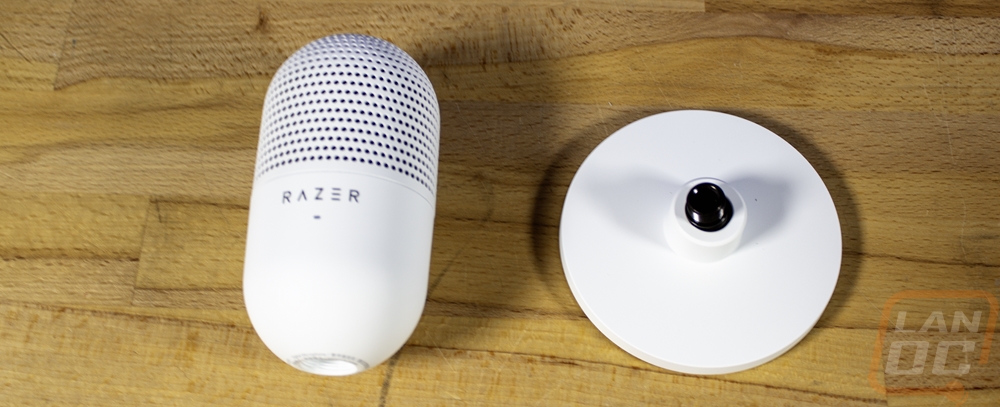

Like with the Seiren v3 Chroma, the Seiren v3 Mini base has a metal insert inside for weight and a plastic cover over the top. This time that plastic is white, but they also match it to the other microphone colors of black and quartz (pink). The bottom of the base however isn’t rubber this time around, for the Seiren v3 Mini they went with foam which is going to be cheaper. That isn’t going to have the same grip or longevity but should still work fine and it does at least some basic isolation. At the top of the base is the threaded end, this has a slight pivot of maybe 10 degrees in any direction.


The Seiren v3 Mini then shares the same pill-like shape of the Seiren v3 Chroma but it is much smaller and has a shorter pill shape. The top half is perforated metal and the bottom half is plastic with it all finished in the bright white for this sample, but as mentioned before you can also get it in black and quartz aka light pink. The front has the Razer logo and just below that a small status LED. There isn’t a front knob like on the Seiren v3 Chroma. The back of the microphone has all of the certification logos and your serial number printed where you won’t see them, then at the bottom, the USB Type-C connection is on the back facing down, not out like on the Chroma. This is why you can’t mount the Seiren v3 Mini directly to the base, but it does make the wiring clean because it keeps it hidden behind the stand. The perforation goes all the way around the microphone and this is a super cardioid design that directs most of the microphone pickup to the front but does pick up some from the back. Then up on top, the Seiren v3 Mini has the same multi-function top button. The button is capacitive so it works when you just touch it, you don’t have to push it to click. But because the Seiren v3 Mini doesn’t have lighting or a knob on the front this top button does the mute with a single tap like the Chroma but with a double tap it will turn the volume up and a triple tap will turn the volume down. The base of the Seiren v3 Mini does have the 5/8 threaded mount so it will be compatible with microphone arms if you want to go that direction in the future.
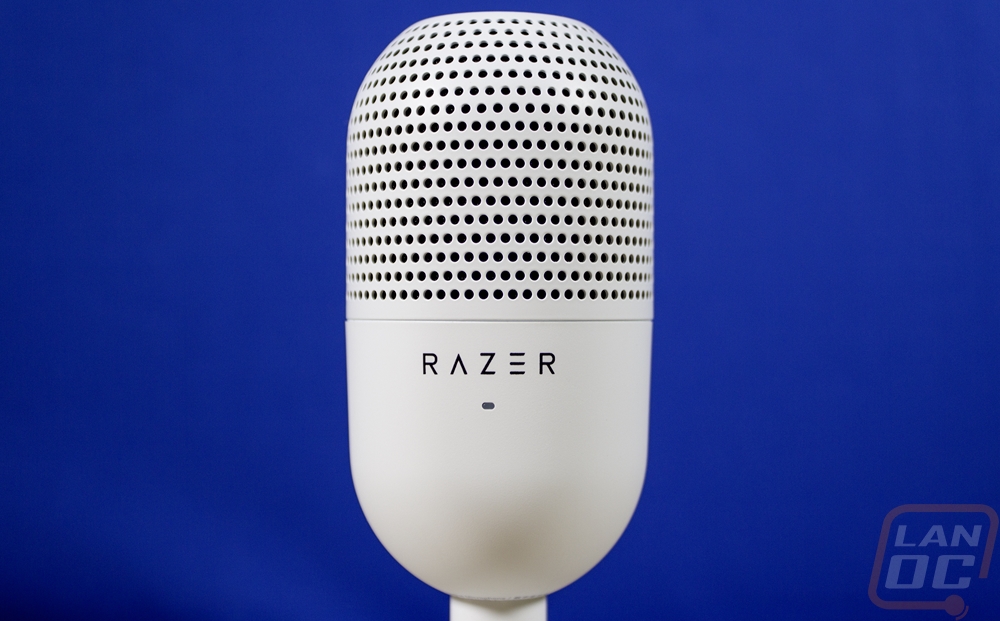




Software and Performance
Before getting into testing both of the Razer Seiren microphones, they use software so let's check that out. Both use Razer’s Synapse software which ties in with all of Razer’s products. So if you already have any other Razer products you won’t have to do too much. Installing it was simple but it does want you to reboot your PC after you install the software which is annoying.


Once set up, this is your main landing page when you open up Synapse. Up top, you have the Razer greep bar with a few main options. A welcome message and then a list of all of your Razer devices with pictures. The device picture could be a little larger. Especially with the ad sitting next to it, the v3 Mini button blends in.

Clicking on the v3 mini’s picture opened up this page which was surprisingly bare. Up top, you have two menu pages and then a drop-down to flip between profiles. The microphone doesn’t have many buttons so you just have control over the top button. The mute and unmute are locked in but you can change the volume up and down or disable those functions if you want. Then below that you have a volume control along with a current sound meter that you can use to make sure you aren’t peaking. Then you can also change the sampling rate as well. With just a few controls, the main thing that bothered me here was that I had to scroll down to see it all when most of the space was empty. If I didn’t double check that there wasn’t anything else I would have most likely never noticed the sampling rate options.
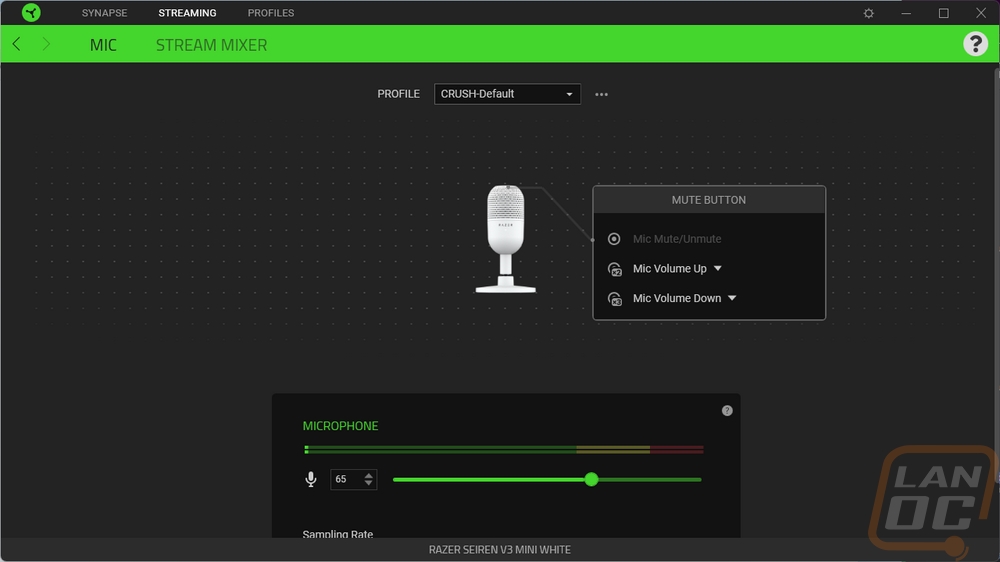


The Stream Mixer page up top has a switch at the top you will need to turn on if you are using this. This will change your audio settings around to give Synapse more control over things. With this, you have stream mix controls including setting your microphone output level differently than your microphone backfeed into your headphones. You can add in additional channels as well. The idea here is that you can set one dedicated audio output to go to your stream and use this software to fine-tune the levels on each audio source.


Switching over to the Seiren v3 Chroma, the main page is similar but does have two sets of button controls because the Chroma has the multi-function top button and the front volume control. I expanded the software out this time around to get everything in one picture but by default, a lot of this is hidden down at the bottom once again. Because the Chroma has a headset output, in addition to the microphone volume control there is also a headphone volume slider. They also has a high pass filter which comes on by default and the advanced gain settings option as well.


The v3 Chroma does have the same Stream Mixer page up top but because I touched on it already there is no point in showing the same features again. What it does have however that the Seiren v3 Mini doesn’t have is a page of lighting controls. The first option here is a brightness slider, by default it was already set to 100% but you can tone things down if you need to or turn the lighting completely off. Then to the right of that is the effects dropdown menu. Razer gives you complete control to make your open effects using their Chroma tool which isn’t part of this software. But even by default, you get a lot of different effects. On top of those effects, they have a few other lighting indicators built in because the Chroma lighting is also the status lighting for the Seiren v3 Chroma. For example, they have a peaking indicator that will turn your lighting to red anytime you are too loud to let you know you need to adjust your microphone volume level down. When you press mute it lights up red as well, either of those can be set to any color but red is what they have by default. Then when you use the front volume control you can see how far you are turned up or down for the microphone or headphones by the color of the lighting changing as well.


For testing, the most important part is how well each of the microphones performed, and for that, I have recordings of both microphones. I tested with the volume set to 100% and nothing else changed from their default settings. I have comparison audio clips from a wide range of other microphones as well. Both the Seiren v3 Chroma and v3 Mini have the same Supercardioid pickup direction. This means that a majority of their pickup comes from the front but they do also pick up some from the back. That, combined with being a desktop microphone does mean that either of the microphones are going to pick up some background noise. It also means that you need to use the adjustment for the microphones to aim them up towards your face. The Seiren v3 Chroma has more adjustment for that, it can be tilted to be vertical if needed whereas the Seiren v3 Mini has a lot less adjustment in its stand. Both are desktop microphones sitting on your desk so the amount of noise they pick up from you moving around and especially from your keyboard will depend on the type of desk you have. For my testing, I have an inch-thick wooden desk. Both didn’t do too bad with background noise, better than some of the other desktop microphones I have tested. You will still always get a better result with a more isolated mounting setup on a microphone arm. The arm lets you get it up at your level, not down below you where it is closer to your mouse or keyboard than your mouth.
Going off of the specifications the Seiren v3 Chroma and v3 Mini have the same frequency range of 20 Hz – 20 kHz and 24-bit bitrate. There are a few differences though, like in the sensitivity where the Chroma has a sensitivity of -34 dB and the Mini is -36 dB. Both have a sample rate of 96 kHz as well. Razer does list the condenser capsule size for the Mini as being a smaller 14 mm size whereas the Chroma has a 16 mm capsule size. So I was especially interested to see how they would sound next to each other. The most noticeable thing is that with the same settings, the v3 Mini was louder. They both do sound similar, however. I saw something similar with the Logitech Yeti GX and Yeti Orb with the cheaper/smaller Orb being louder. Overall though both of the Razer microphones seem to have a little more bass on my voice which sounds a little fuller. The two Yeti microphones, which are the direct competition to these microphones do have a lot more adjustment on the software side. With both Seiren microphones, you get what you get, but the Yeti’s have the option to tune things. Thankfully both of the Seiren v3 microphones sound good out of the box.
Beyond the microphone performance, how was the overall functionality? Well, I’m not normally a big fan of capacitive buttons, I prefer something with a little feedback but the capacitive multi-function button on top of both microphones wasn’t too bad. With the Seiren v3 Mini, this is the only control you have. You can use the top button to change your microphone volume settings using the double and long presses but I didn’t find that to be as useful, I would still prefer to use the software for that. You also have the front status LED on the Mini which makes it easy to see when you are muted.


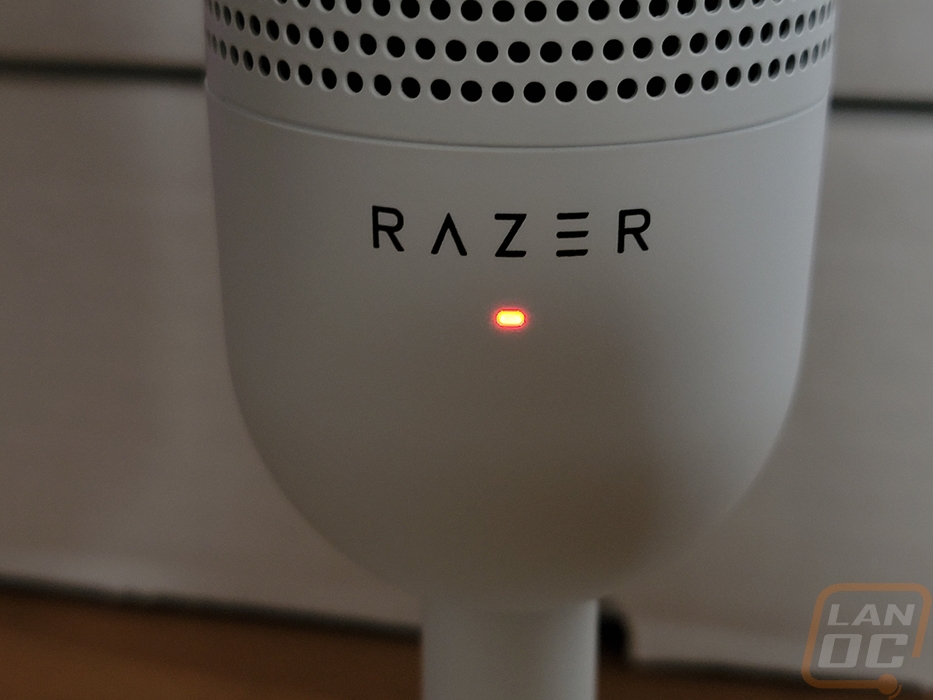
For the Seiren v3 Chroma, it has the front knob and that opens up better control with the ability to adjust your microphone volume and also the volume for the built-in headphone output as well. You do have to use the top button’s secondary functions to switch between those two which can be a little confusing especially because all of the lighting on the microphone itself is your status indicator. But having the control there is a big step up from the Mini. The quick tap on top is the same as on the Seiren v3 Mini and that means it is easy to reach and quickly mute or unmute. Having the whole microphone turn red when muted is great, as long as you weren’t planning on running red as your normal color. But you can change that if you need in Razer’s Software.
The lighting on the Seiren v3 Chroma is its biggest feature. With everything behind the perforated grill lit up it does look good even if I personally don’t need an over the top RGB setup. Even before getting into the other effects that you can create or pick from, the base lighting rotates through different colors. Then down at the bottom of the pictures below you can see the microphone lit up red while being muted.


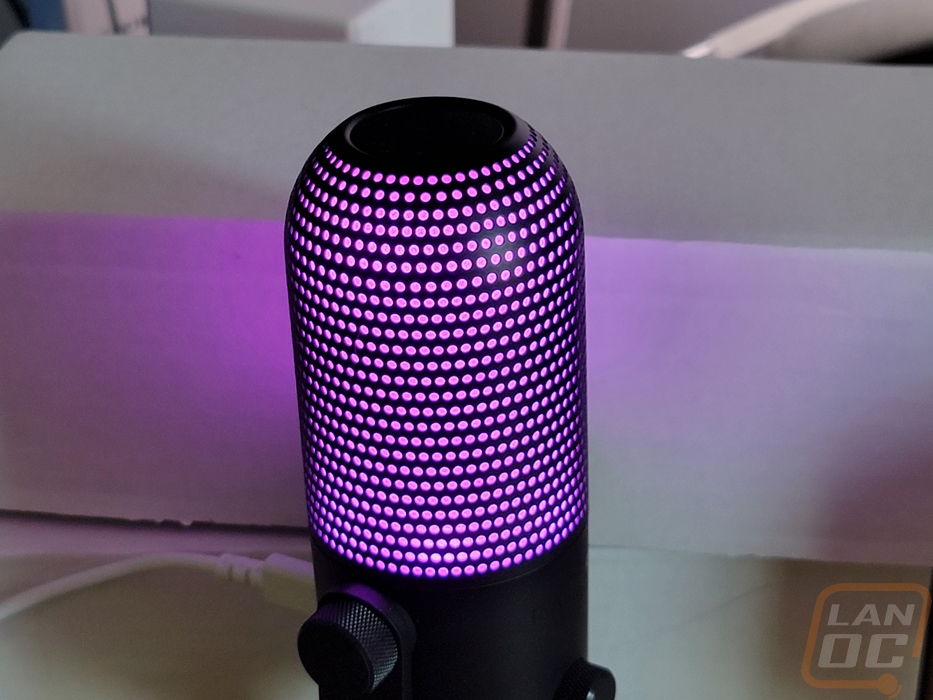



Overall and Final Verdict
Going all the way back to when I took a look at the first Razer Seiren microphone to come into our office 9 years ago I’m happy to see that Razer has continued to evolve. Their two latest microphones continue that evolution and also mirror what I’ve seen from a lot of the competition as well with having two different models with one cheaper budget-friendly option like the Seiren v3 Mini and then a higher end flashy microphone like the Seiren v3 Chroma. The Seiren v3 Chroma adds in a lot more metal into its design which makes it feel a lot more stable along with a mount that is closer to a traditional microphone setup. That mount design does still sit on your desk which opens up some potential issues but it can be angled up correctly and does a better job isolating the microphone even when compared to the Seiren v3 Mini. The Seiren v3 Chroma also has fully embraced the RGB life with the entire perforated housing being backlit with Razer Chroma lighting. You get a volume control knob on the front and a headphone jack and the audio performance was great but a little quieter than the Seiren v3 Mini. The top button is easy to reach and the mount setup does support being added to an arm as a nice upgrade in the future. For downsides, the Seiren v3 Chroma does use the Chroma lighting for all of its status indicators which I would still prefer to have dedicated LEDs for a few things, though having the entire microphone light up red when it is muted is nice. Razer is also behind Logitech on the software side when it comes to the amount of control you have over your audio settings, the comparable Logitech Yeti GX has all of the voice effects and basically a full mixer to help tune out any issues but the Seiren v3 Chroma doesn’t have most of that. Also on the software side, you do have to do a reboot after installing it or even after adding the Seiren v3 Chroma which is annoying.
The Seiren v3 Mini shares a lot of the same features as the Seiren v3 Chroma including the the most part its performance which made this especially good considering its size and price. The Seiren v3 Mini has a lot more compact design though which for a lot of people will be easier to deal with on your desk. It does have a metal perforated section but the rest of its construction including a lot of the mount is plastic but because the base has metal in it it does feel a lot more solid than the Yeti Orb that it competes with. Razer also offers the Seiren v3 Mini in three different colors with white, as I tested, black, and a cool Pink that they call Quartz. Its compact base however doesn’t have much adjustment and is hard to tilt up to aim at your mouth but it has been threaded to support a microphone boom arm mount if you want to upgrade in the future. The top-mounted mute button is easy to reach and use and while both microphones use a capacitive button for this which I normally am not a big fan of I don’t hate it in this situation. Like with the Seiren v3 Chroma, on the software side of things, the Seiren v3 Mini is behind the Yeti competition, specifically on how much control Yeti’s have in mixing your sound and with fun voice effects. But when it comes to pure performance the Seiren v3 Mini was still surprisingly good.
As for pricing, the Seiren v3 Chroma has an MSRP of $129.99 and the Seiren v3 Mini will run you $59.99. The Seiren v3 Mini is spot on pricing when compared to the Yeti Orb which is also $59.99. Then the Seiren v3 Chroma is actually a little less than the Yeti GX which was $149 and is currently listed at $135. Adding in a microphone arm in the future would be a big help for either, they did a solid job of isolating desk noise but that would be the next step to go even further. But overall performance wise either would still be a good option, especially if you are already in the Razer ecosystem. But I do hope that they expand on the control you have to tune your sound in the future to be more competitive in that aspect.


Live Pricing: HERE


Live Pricing: HERE




